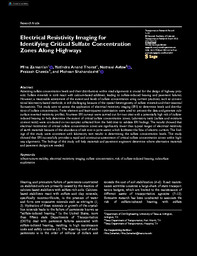
ATTENTION: The works hosted here are being migrated to a new repository that will consolidate resources, improve discoverability, and better show UTA's research impact on the global community. We will update authors as the migration progresses. Please see MavMatrix for more information.
Show simple item record
| dc.contributor.author | Zamanian, Mina | |
| dc.contributor.author | Thorat, Yatindra Anand | |
| dc.contributor.author | Asfaw, Natnael | |
| dc.contributor.author | Chavda, Prakash | |
| dc.contributor.author | Shahandashti, Mohsen | |
| dc.date.accessioned | 2023-07-17T16:52:00Z | |
| dc.date.available | 2023-07-17T16:52:00Z | |
| dc.date.issued | 2023-05-15 | |
| dc.identifier.uri | http://hdl.handle.net/10106/31559 | |
| dc.description.abstract | Assessing sulfate concentration levels and their distributions within road alignments is crucial for the design of highway projects. Sulfate minerals in soils react with calcium-based additives, leading to sulfate-induced heaving and pavement failures. However, a reasonable assessment of the extent and levels of sulfate concentration using current practices, such as conventional laboratory-based methods, is still challenging because of the spatial heterogeneity of sulfate minerals and their seasonal fluctuations. This study aims to assess the application of electrical resistivity imaging (ERI) to determine levels and distributions of sulfate concentration. Finite element and least-squares optimization were used to process the data and generate subsurface inverted resistivity profiles. Fourteen ERI surveys were carried out for two sites with a potentially high risk of sulfate-induced heaving to help determine the extent of critical sulfate concentration zones. Laboratory tests (sulfate and moisture content tests) were conducted on ten samples collected from the field sites to validate ERI findings. The results showed that electrical resistivities of critical sulfate concentration zones are significantly lower than typical ranges of electrical resistivity of earth materials because of the abundance of salt ions in pore water, which facilitates the flow of electric current. The findings of this study were consistent with laboratory test results in determining the sulfate concentration levels. This study showed that ERI successfully provides a rapid and continuous assessment of critical sulfate concentration zones within highway alignments. The findings of this study will help materials and pavement engineers determine where alternative materials and pavement designs are needed. | en_US |
| dc.language.iso | en_US | en_US |
| dc.publisher | SAGE | en_US |
| dc.subject | infrastructure stability | en_US |
| dc.subject | electrical resistivity imaging | en_US |
| dc.subject | sulfate concentration | en_US |
| dc.subject | risk of sulfate-induced heaving | en_US |
| dc.subject | subsurface exploration | en_US |
| dc.title | Electrical Resistivity Imaging for Identifying Critical Sulfate Concentration Zones Along Highways | en_US |
| dc.type | Article | en_US |
| dc.rights.license | Licensed under Creative Commons: CC BY-NC 4.0 | |
Files in this item
- Name:
- zamanian-et-al-2023-electrical ...
- Size:
- 12.46Mb
- Format:
- PDF
- Description:
- Article
This item appears in the following Collection(s)
Show simple item record


